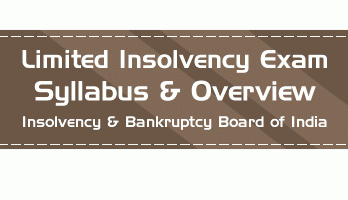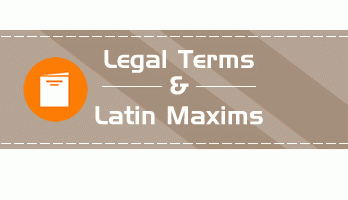26 The provisions of which of the following apply to the proceedings before a special court under the Insolvency and Bankruptcy Code, 2016?
a) the Code of Criminal Procedure, 1973
b) the Indian Penal Code, 1860
c) the Insolvency and Bankruptcy Code, 2016
d) the Civil Procedure Code, 1908
Ans. (a)
27 A financial creditor needs to file an application for initiation of corporate insolvency resolution process in Form appended to the Insolvency and Bankruptcy (Application to Adjudicating Authority) Rules, 2016.
a) Form 2
b) Form 1
c) Form 3
d) Form 4
Ans. (b)
28 An operational creditor desirous of initiating a corporate insolvency resolution process needs to deliver to the corporate debtor a demand notice in Form appended to the Insolvency and Bankruptcy (Application to Adjudicating Authority) Rules, 2016?
a) Form 2
b) Form 3
c) Form 1
d) Form 6
Ans. (b)
29 A corporate applicant shall send a copy of the application in Form 6 appended to the Insolvency and Bankruptcy (Application to Adjudicating Authority) Rules, 2016 to the registered office of the Corporate debtor by
a) Speed post
b) Courier
c) E-mail
d) By hand
Ans. (a)
30 A corporate applicant is required to obtain a written communication in Form 2 appended to the Insolvency and Bankruptcy (Application to Adjudicating Authority) Rules, 2016 from the proposed interim resolution professional stating that he
a) agrees to accept the appointment.
b) refuses to accept the appointment.
c) agrees to accept the appointment subject to certain conditions.
d) agrees to accept the appointment jointly with another insolvency professional.
Ans. (a)
31 An operational creditor shall pay a fee Rs…. along with an application for initiation of corporate insolvency resolution process.
a) 25,000
b) 15,000
c) 5,000
d) 2,000
Ans. (d)
32 The public announcement regarding initiation of corporate insolvency resolution process may not be made
a) in newspapers.
b) on the website of the corporate debtor.
c) on the website designated by the Insolvency and Bankruptcy Board of India.
d) on the website of the Insolvency Professional Agency.
Ans. (d)
33 Which of the following cannot be used by a financial creditor to prove existence of a debt under corporate insolvency resolution process?
a) an order of a court or tribunal that has adjudicated upon the non-payment of a debt.
b) a contract for the supply of goods and services with corporate debtor.
c) a financial contract supported by financial statements as evidence of the debt.
d) the records available with an information utility.
Ans. (b)
34 Who convenes the meeting of committee of creditors?
a) the financial creditor with the largest amount of claim
b) the Managing Director of the Corporate Debtor
c) the resolution professional
d) the applicant
Ans. (c)
35 Which of the following is true about sale of assets by a resolution professional during corporate insolvency resolution process?
a) The resolution professional can sell any asset with the approval of the committee of creditors.
b) The resolution professional can sell only unencumbered assets with the approval of the committee of creditors.
c) The resolution professional can sell unencumbered assets, not exceeding 10% of the claims admitted, with the approval of committee of creditors.
d) The resolution professional cannot sell any asset.
Ans. (c)
36 The Registered Valuers appointed by the Resolution Professional are required to estimate the liquidation value on the basis of
a) physical verification of assets of the corporate debtor.
b) records of the corporate debtor.
c) records of the information utilities.
d) records with Depositories.
Ans. (a)
37 A resolution applicant shall endeavor to submit the resolution plan ….
a) within 30 days before the expiry of the maximum period permitted for corporate insolvency resolution process.
b) within 30 days of the first meeting of committee of creditors.
c) by the time line set by the committee of creditors.
d) by the timeline set by the resolution professional.
Ans. (a)
38 A person proposed to be registered as an insolvency professional agency must have a minimum net worth of
a) Rs.5 crore.
b) Rs.10 crore.
c) Rs.2 crore.
d) Rs.1 crore.
Ans. (b)
39 In case the application for registration of an insolvency professional agency is having some defect, the Insolvency and Bankruptcy Board of India may:
a) reject the application.
b) give additional time to the applicant to remove such defects.
c) refer the application to National Company Law Tribunal.
d) Grant a provisional registration subject to correcting such defects.
Ans. (b)
40 The notice of receipt of an application for surrender of registration by an insolvency professional agency shall be published by the Insolvency and Bankruptcy Board of India on its website within — days of its receipt.
a) 2
b) 5
c) 7
d) 10
Ans. (c)
41 The appeal against an order of the Insolvency and Bankruptcy Board of India suspending the registration granted to an insolvency professional agency may be preferred to
a) National Company Law Tribunal
b) National Company Law Appellate Tribunal
c) High Court having jurisdiction
d) Supreme Court
Ans. (b)
42 The governing board of an insolvency professional agency may amend its bye-laws by a resolution passed by votes being not less than … times the number of votes, if any, cast against the resolution.
a) 2
b) 3
c) 4
d) 5
Ans. (b)
43 Which of these is not a mandatory committee to be formed by the governing board of an insolvency professional agency under the model bye-laws?
a) Risk management committee
b) advisory committee
c) grievance redressal committee
d) monitoring committee
Ans. (a)
44 In case of application for enrollment of a professional member has some deficiency, the insolvency professional agency may ….
a) reject the application and ask for fresh application.
b) give an opportunity to the applicant to remove the deficiency.
c) refer the application to the National Company Law Tribunal.
d) refer the application with its recommendation to the Insolvency and Bankruptcy Board of India.
Ans. (b)
45 Where a professional member has committed an offence involving moral turpitude, the disciplinary committee of the insolvency professional agency may ….
a) suspend the member.
b) expel the member.
c) Impose a monetary penalty.
d) refer the matter to the Insolvency and Bankruptcy Board of India.
Ans. (b)
46 Which among the following is not eligible for registration as an insolvency professional under the Insolvency and Bankruptcy Board of India (Insolvency Professionals) Regulations, 2016?
a) Pass in National Insolvency Examination
b) Pass in Limited Insolvency Examination and Experience of 10 years in management after receiving bachelor’s degree
c) Pass in Limited Insolvency Examination and Experience of 10 years as a Chartered Accountant
d) Pass in Limited Insolvency Examination and Experience of 10 years as a Company Secretary
47 The limited period registration granted to an insolvency professional is valid for months.
a) 3
b) 6
c) 9
d) 12
Ans. (b)
48 Which of the following is not eligible to be registered as an insolvency professional entity?
a) a company where majority of whole time directors are insolvency professionals
b) a partnership firm where majority of partners are insolvency professionals
c) a trust where majority of trustees are insolvency professionals
d) a limited liability partnership firm where majority of partners are insolvency professionals
Ans. (c)
49 Remuneration charged by an insolvency professional need not be ….
a) transparent.
b) reasonable.
c) lowest.
d) disclosed to stakeholders.
Ans. (c)
50 As per report of the Bankruptcy Law Reforms Committee, which of the following is not an objective of an insolvency and bankruptcy regime?
a) Low time to resolution
b) Low time loss in recovery
c) Higher levels of debt financing
d) Lower levels of equity financing
Ans. (d)






